1. Mulberry silk tops & bricks
2. Mulberry silk noils
3. Mulberry silk hankies & Mawata silk caps
4. Silk with Sericin (gummed silk) (opens a new page)
4.1. Cocoons
4.2. Carded cocoon strippings or floss
4.3. Throwster’s waste
4.4. Silk carrier rods
The best silk cocoons are used for reeling top quality yarn. The residual silk from the reeling operation is sold as throwster’s waste and silk carrier rods. Cocoons that are not good enough for reeling are degummed and either made into silk hankies or they are carded and made into silk tops which can be spun like wool. The leftovers of the carding process are the silk noils, which can be used to add texture to handspun yarns.
You can buy mulberry silk in various forms, and they are useful for spinning, making silk paper or combining with felt. Most commercial silk is degummed, which means that the sericin has been removed. Silk tops are the most common type of silk sold for spinning, but there are other types of silk that you can use.
Silk hankies have very much longer fibres than silk tops, as they are made from cocoons that were stretched over a frame. Once you know how to use hankies you may find them easier to spin and dye than silk tops. These long silk fibres also spin into a strong yarn. Silk noils are not so strong but they are great for adding texture.
|
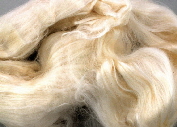
|
|
Mulberry silk tops
|
|
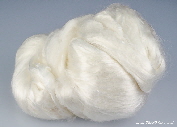
|
|
Mulberry silk brick
|
|
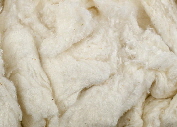
|
|
Mulberry silk noils
|
|
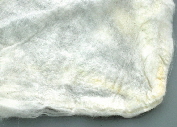
|
|
Mulberry silk hankies
|
|
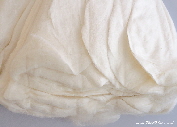
|
|
Mawata silk caps
|
|
1. Mulberry silk tops and silk bricks
Some of the better quality silk that is not suitable for reeling is degummed, carded and combed and then either made into silk tops or silk bricks. Tops or bricks are made of overlapping lengths of silk filament (each filament is about 15 to 25 cm long), just like wool tops. You cannot reel silk from silk tops, only from cocoons. Silk tops are great for spinning into lustrous yarns or made into silk paper.
Silk bricks used to come in tightly folded rectangles about 8 cm wide, hence the name; nowadays they are much more loosely balled. Silk bricks are a thick sliver at approximately 20 grams per meter. Silk tops are very similar to silk bricks, but they are thinner and longer (about 6 grams per meter).
You can use silk bricks and silk tops interchangeably; both are high quality lustrous silk that take dyes beautifully. However, as the silk brick is thicker and wider than silk tops you may find it easier to draw the fibres when you are using them in silk fusion (i.e. silk paper making) or when you are blending them with another fibre in a drum carder.
You may find silk tops to be slightly easier to use for hand spinning. You can spin silk tops in a similar way to spinning wool. However, silk can feel somewhat slippery when you spin so you need to hold it with a firmer grip than usual and add more twist. Some spinners prefer to spin silk from the fold but you need to be careful not to get the top in a tangle. If you are new to spinning silk, you may like to start with tussah silk tops, which are easier to spin and easier to use in blends than mulberry silk.
2. Mulberry silk noils
After the degummed silk cocoons have passed through the carders, some fibres are left in the teeth of the carders. These leftover short broken fibres are the silk noils.
Although silk noils don’t look interesting, they are a wonderful soft fibre to add texture to hand spun yarns. Silk noil is sometimes called raw silk, but this is incorrect, as raw silk still has sericin. Noils have been degummed and are therefore free from sericin, which makes them easy to dye with natural dyes. You can use them to add texture to handspun yarn, to felt and for silk paper making.
3. Mulberry silk hankies & Mawata silk caps
Silk hankies resemble millefiori pastry but have frilly edges and are sold in a stack of several fine layers. The cocoons of the mulberry silk worm are softened in warm, soapy water and stretched over a frame that is square (approx 25 cm square) for hankies. Mawata caps are stretched over a ‘U’ shaped bamboo framework. Mawata is the Japanese word for ‘spread out’ and refers to the stretching of the cocoon. In Japan, silk hankies were originally used to pad the inside of winter kimonos.
Several cocoons are stretched over the frame so that each hankie or cap is composed of many layers, each containing the silk fibres of one cocoon. Usually cocoons that are not suitable for reeling are used. If you separate one hanky from the bundle and hold it against the light you will see how thin it is. You will probably notice that there is one small patch where the silk is thicker than the rest. This is the cradle, which is the last bit that the silk worm spun.
4. Silk with Sericin (opens a new page)
4.1. Cocoons
4.2. Carded cocoon strippings or floss
4.3. Throwster’s waste
4.4. Silk carrier rods
Top of page
|

